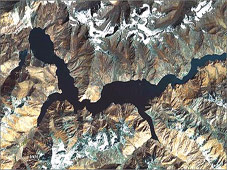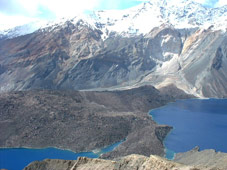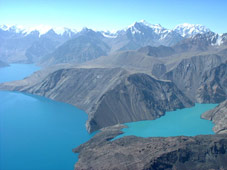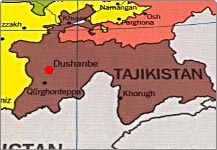Sarez lake
 | Lake Sarez - Tajikistan's biggest naturally formed, rock-dammed lake created on 6(18) February of 1911 at 23:15 as a result of earthquake of 7.5 points according to Richter scale caused a massive land slide of 2,2 km3 which sealed off Murgab river valley and buried Usoi village with all the inhabitants. The created dam is 567 metres tall and 4 km wide and is currently the highest natural dam in the world. |
A sealed off Murgab river flood the area and another village Sarez located upstream in the same year. A lake was named after Sarez village while the dam is known as Usoi dam after the village buried under the mass of the mud slide. Sarez is the youngest lake in the world. In 1913 the first research shown the lake to be 28 km long, 1,5 km across and 279 m deep. Every day the water level grew up for 36 sm and only in 1914 Sarez waters created an outflow thru the dam and gave start to Bartang River - one of the Pyanj feeders.
| Since then a lake has grown to 55.8 km in length, 3,3 km across and 500 metres deep at its deepest point. The lake's volume is curently 16, 074 km3 which is equal to Oxus annual discharge. In 1939 a hydro meteorological observatory was opened on the lake's shore for permanent control over the lake's waters as some sources believe the lake pose potential risks for downstream communities. |  |
Should another strong earthquake or rock slide occur in the lake's vicinity, the Usoi dam may give a crack or dam's 'right bank'- a partially collapsed body of earth and rock with a mass of roughly 3 cubic kilometres-might fall into the lake. The displacement could generate a wave large enough to wash away Usoi dam and release a wall of water that could flood some 6 million people living downstream along the Bartang, Pyanj and Amu-Darya rivers in Afghanistan, Uzbekistan, and Turkmenistan, as well as in Tajikistan.
 | While catastrophic scenarios about the future of Lake Sarez are easy to come by, measures to mitigate the threats it poses are less so. Scientists still debate on what should be undertaken - some say about pumping station which would pump the water out of the lake the others about the need of drilling into Usoi dam in order to release water in controlled circumstances and reduce the pressures on the structure. |
In the face of this uncertainty, the government and international community continue to monitor water levels and pressure in Lake Sarez-which, at the moment, seem relatively stable.
Home | Travel Basics | Tours | Visa&Formalities | Must See | FAQ's | About us





 Little Pamir 22 day
Little Pamir 22 day




